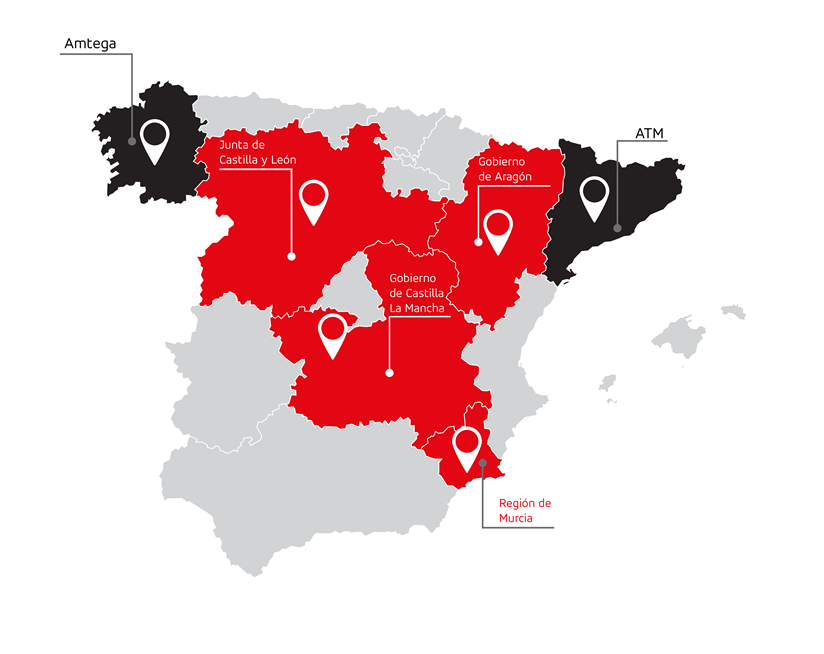Article: At the cutting-edge of intelligent regional transportation systems

The population in rural areas of the European Union (EU) is generally older than in urban areas. Over the next 10 years, this population is also expected to begin to diminish. Added to the lack of connectivity, underdeveloped infrastructure, lack of job opportunities, and limited access to services, this has made rural areas less appealing places to live and work.
Nonetheless, rural areas play an active role in the European Union’s ecological and digital transition. Achieving the EU's ambitious digital targets for 2030 may offer more opportunities for the sustainable development of these areas beyond agriculture, livestock, and forestry, as it creates new prospects for growing the manufacturing industry and especially the service industry, and because it helps improve geographic division of services and industries.
Within this context, the European Commission presented the European Union Rural Action Plan in June 2021 to drive comprehensive, cohesive, sustainable rural development. This plan defines various scopes of activity, supported by emblematic initiatives aimed at helping rural areas to become stronger (training rural communities, improving their access to services, and facilitating innovation); more connected, both in terms of transportation and in terms of access to digital services; and more prosperous, diversifying their economic activities.
The demographic issue as well as territorial and social unity are challenges facing all of Europe requiring clear decision-making focused on the spaces most affected by territorial inequality: small towns and rural areas.
Experience has shown that the territorial concentration model has not had a driving effect on surrounding areas. The main consequence of this is a lack of social equity that has sometimes materialized in a difference in opportunities based on where people live. This scenario is the basis for the need to recover polycentric territorial development plans to drive small and medium-sized cities as well as rural areas.
Toward sustainable mobility
Regional interurban transit is characterized by having many routes with low traffic, low occupancy, and little financial cover. In fact, many of the regular transit lines providing regional services have negative operating profits. Most of them are money-losing ventures that offer a variety of routes connecting towns with small populations with major cities. Since they are public services, their main goal is to guarantee citizens’ mobility.
In this context, transportation infrastructure is an essential component in developing territories, fostering social and territorial unity, boosting productivity, and improving competitiveness and the economy’s export capacity. Thus, these infrastructures must be reliable, sustainable, resilient, and high-quality.
The path toward sustainable mobility requires a framework for public and private collaboration facilitating and accelerating the implementation of efficient solutions, among other aspects. Nonetheless, not only public agencies need to assume this duty, private companies can also do their part and accelerate fulfillment of this need, which is really a mandate from the people.
The messages from Europe on reducing emissions are bolstered by the European Recovery Program driven by the European Commission in response to the COVID-19 pandemic. The program’s aim is once again to drive transformative projects to advance toward a more digital and sustainable Europe. The purpose of the European funds is to promote economic, social, and territorial unity within the European Union based on the digital transformation, ecological transition, and growth. Transforming mobility is decisive for a country’s economy and for its citizens. This huge commitment from the European Union presents a challenge for the necessary cooperation and collaboration between public institutions and the private sector that will accelerate the transformation toward sustainable mobility.
Sustainable mobility goals
In order to boost the resilience of transportation infrastructure in response to new demands and challenges, a range of sustainable mobility goals have been defined including digitization and sustainability in transportation.
In view of the needs of the model of regular regional public transportation, a set of requirements has been defined including driving transladem, incorporating school transportation with joint service formulas to create a more efficient and sustainable system, and managing mobility flows based on areas of influence.
In this context, the technology and architecture implemented to address these challenges should not only ensure proper functioning and modernization of the systems currently in use, but also its maintenance, adaptability, and future scalability.
This must all be taken into consideration with interoperability with third parties, use of international standards, application of open, public norms, user-centricity, and an open and modular architecture.
GMV has shown that it has a powerful, innovative solution to fulfill these needs. It is a solution that is also comparable to other areas beyond regions, such as metropolitan transit authorities and regional transit consortiums, as well as equivalent government agencies internationally. The systems implemented by GMV stand out for several reasons. First, they stand out for their capacity to have standardized and centralized information about all the services available, as well as their capacity to provide a real-time flow of information to service users, which reduces wait times at stops, among other benefits. These systems also allow for more exhaustive and friendlier real-time control of ticketing, streamlining tasks for administrative personnel and facilitating planning, design, and operation of transportation services with immediate diagnostics.
Intelligent transportation systems (ITS) central systems, which make up the highest level of the architecture defined by customers, include the supply of a control center able to integrate data from multiple operators. This control center is comprised of a back-end with all the major modules and the necessary business logic in the system to implement the functionalities as well as a front-end for users, allowing each user to uniquely access information based on their permissions and hierarchical level.
The platform also includes a common business intelligence module to analyze and leverage the mobility and metrics data accessible to the operations personnel of the various players using control panels and reports generated flexibly within the system through a web tool that can be accessed based on the permissions and roles defined for the (internal or external) personnel.
Specifically, the control center contains functionalities related to the computer-aided dispatch/automatic vehicle location system (CAD/AVL), providing an architecture based on the latest technology and software quality standards with applications that can be implemented and modified separately and comprehensively without missing information, duplicate data, or redundant processes. It also includes validation and sale functions in line with the need to digitize all the usual means of payment accepted around the world, allowing travelers to access transit using transit cards, QR codes, and bank payments.
The control center also provides travelers with information, sending it via standard open protocols to feed other systems using similar standards like GTFS and the CEN NeTEX standard, real-time GTFS-RT data, CEN SIRI standard data, as well as efficient and open non-standard information interfaces. Finally, the control center allows integration with other systems via standards both within the ITS architecture defined by the customer (such as integration with level 3 ITS administration architecture, as shown in the following figure) and with external systems.
ITS Suite
After more than 25 years providing ITS solutions on all continents, GMV has implemented and will continue to implement the best ITS technology available on the market. This technology is the product of the evolution of solutions rolled out over the last five years providing excellent service given their experience and maturity.
GMV’s solution is based on ITS Suite, a next-generation, state-of-the-art, expandable, scalable, open system following a microservices architecture. This software stands out not only for its cutting-edge technology, but also for its first-class user experience, prioritizing usability for users, operators, and system admins.
These systems are based on the principles of scalability and interoperability. They are also based on international norms and standards allowing efficient operational integration both between different levels of the implemented ITS model and with other external systems.
They offer a wide range of advantages, as they optimize the processes involved and allow for digitization of administrative systems and public transportation data availability in two different forms: real-time and historical data. This results, in turn, in users having access to a higher-quality, more secure, and more inclusive public transportation service with optimized, personalized information.
Finally, these systems will allow for cooperation and information exchange with other public agencies with transportation competencies, which will foster the potential for digitization to become more developed, allowing for interconnectivity between modes of transportation, infrastructures, and the territory as a whole, thereby optimizing the transportation system at a national level.
GMV leadership in regional ITS systems in Spain
In the particular case of a rural context like the Spanish one, with small, scattered population centers occupying 84.1% of the surface area and an aging population – people 65 and over make up 23.8% of the population in rural areas vs. 18.4% in urban areas, according to the Ministry of Agriculture, Fisheries, and Food 2019 annual indicator report – the lack of high-quality services is particularly detrimental to young people and seniors who are less autonomous. To take on these challenges and ensure mobility is sustainable, policies and actions must guarantee universal accessibility to basic services, promoting efficient public transportation alternatives adapted to the population's needs.
Given the above, as part of Component 6 of the Recovery, Transformation, and Resilience Plan (within the national plans drafted by the 27 Member States of the European Union to join the European recovery plan NextGenerationEU), a variety of measures and investments have been included to modernize, digitize, and enhance security and sustainability for key interurban and intermodal transportation infrastructures throughout Spain.
Within this context, various autonomous communities put out invitations to tender in 2023 to supply and implement a central ITS management system that will allow all interurban public transportation information to be integrated into the various licenses in the corresponding license maps and to manage all the services to be generated based on this information for the administrators, operators, and citizens, so as to improve the technological systems associated with regional public transportation.
GMV has shown that it has a strong and innovative solution to respond to the needs of regional public agencies. Within this context, the company has been supplying the transport management system in Galicia since 2015, integrating the information of 127 licenses and more than 3,500 vehicles belonging to the various transportation operators on the roads of Galicia with their CADs, and in 2022 it updated the Barcelona ATM’s multi-fleet computer-aided dispatch/automatic vehicle location system (a pioneering system initially implemented in 2001). Continuing this leadership position, GMV was awarded the development and rollout of the digitization platforms for Castille León, Castille-La Mancha, the region of Murcia, and Aragón. The solution implemented by GMV is a cutting-edge system that is expandable, scalable, interoperable, and open, making it replicable both on a national and international scale.
This article and much more in GMV News 89

